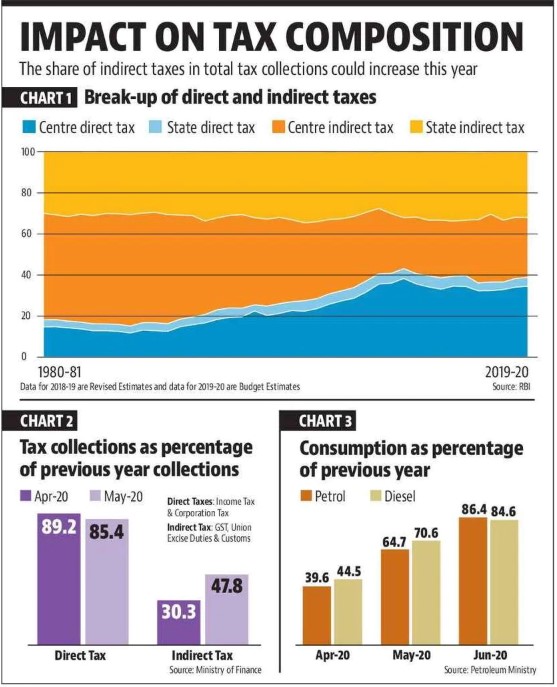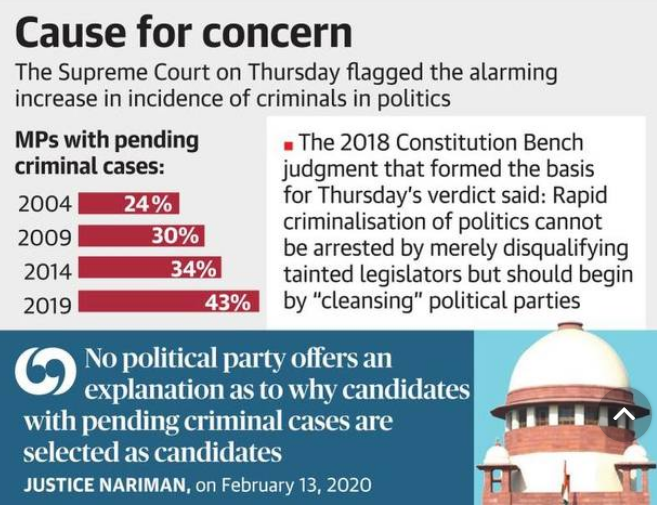Contents
- Covid-19 may further skew India’s tax profile
- What was said recently about India – U.S.
- U.S. orders China to close Texas consulate
- Security agencies red-flag firms with connection to Chinese govt.
- 24% of Rajya Sabha members face criminal cases
COVID-19 MAY FURTHER SKEW INDIA’S TAX PROFILE
Focus: GS-III Indian Economy
Introduction, How Indirect tax varies from Direct tax
- Direct taxes are progressive in nature – the rich pay at a higher rate than the poor – and a fall in share of direct taxes in total revenue entails retrogression in the tax burden.
- Indirect taxes do not make the distinction between rich and the poor in a sense that Petrol is sold at the same rate whether it is meant for a motorcycle or an expensive car, and the tax paid for that is the same.
Two Crucial contradictions in Indian Economy
- India’s political economy landscape has two basic contradictions. Agriculture produces less than 15% of the GDP, but employs more than 40% of workers.
- Just a little over 50 million of India’s 400 million workers pay income taxes.
Recent Developments
- In July 2019, finance minister imposed a surcharge on the super-rich, which took the peak income tax rate to 42.7%.
- Towards the end of 2019, the government announced a major reduction in corporate tax rates, which it then estimated would lead to a revenue loss of Rs 1.45 lakh crore.
- The share of direct taxes in the Centre’s gross total revenue came down by 2.5% points from the 2018-19 level.
Reading the Data:
- RBI data shows that direct taxes, which include income tax and corporate tax, had a share of less than 40% in total tax revenue of the centre and states.
- The share of direct taxes increased sharply in the decade preceding the 2008 financial crisis.
- The share of direct taxes reached a peak in 2009-10 and has stagnated at a slightly lower value since.

How will the pandemic affect this distribution?
- A comparison on a year on year basis shows direct taxes suffered a bigger shortfall in comparison to indirect taxes in the first two months of the fiscal year.
- Total collection of corporate tax and income tax in April and May was almost 15% less than the collection in the same months of 2019, and similarly, collection of the Goods and Services Tax (GST), customs and excise duties, three major indirect tax heads is more than 50% less than that in 2019.
- While indirect tax collections vis-a-vis previous year’s collections improved in May, direct tax numbers seem to have followed the reverse trend.
Recovery in sight?
- Both the central and state governments have increased taxes on petrol and diesel rather than passing the advantage of low crude prices to the consumers.
- With petrol and diesel consumption inching back to normal levels, governments will make a windfall in taxes.
- Companies might have held back on lay-offs and pay-cuts in the early months of the lockdown, and as the lockdown was not short-lived as the companies would have hoped for – this means that outlook on profits and salaries, and therefore direct tax collections, will worsen overtime.
-Source: Hindustan Times
WHAT WAS SAID RECENTLY ABOUT INDIA – U.S.
Focus: GS-II International Relations
Why in news?
- External Affairs Minister has said that the U.S. needs to learn to work with a more multipolar world and “go beyond” alliances – at the U.S. India Business Council’s India Ideas Summit.
- At the same summit, the Prime Minister invited U.S. companies to invest in India’s healthcare, infrastructure, defence, energy, farm and insurance sectors, saying the country offers openness and opportunities.
- U.S. Secretary of State has said countries like India and the U.S. should work together to face the “challenge” of the Chinese Communist Party (CPC).
Details
External Minister’s Comments
- The trade differences between India and the U.S. could be resolved and the relationship be shifted to a higher level.
- India was changing and the conversations India and the U.S. were currently having as, “rebalancing of the world economy conversations” where “up and coming players” have some different concerns from “established players”.
Prime Minister’s Appeal for Investment
- U.S. Investors should consider investing in India as India offers a perfect combination of openness, opportunities and options, celebrating openness in people and in governance.
- COVID-19 pandemic had shown the importance of economic resilience, which can be achieved by stronger domestic economic capacities.
- The government had made many efforts to make the Indian economy more open and reform-oriented.
- Reforms have ensured increased competitiveness, transparency, digitisation, innovation and policy stability.
U.S. Secretary of State’s thoughts
- It’s important that democracies like India and U.S. work together, as there is a visible scope of the challenge posed by the Chinese Communist Party.
- Our infrastructure projects, our supply chains, our sovereignty, and our people’s health and safety are all at risk if we get it wrong.
- India too, is an important partner and a key pillar of president’s foreign policy: multi-lateralism that actually works.
Overview of Indo-American relations
- India-US relations have become increasingly multi-faceted, covering cooperation in areas such as trade, defence and security, education, science and technology, civil nuclear energy, space technology and applications, environment and health.
- Grassroot level interactions between the people of the two nations provide further vitality and strength to this bilateral relationship.
- There have been regular contacts at political and official levels with a wide-ranging dialogue on bilateral, regional and global issues having taken place.
Divergent issues in Indo-U.S. relationship
- In June 2019, the Trump administration decided to terminate India’s benefits under the Generalised System of Preferences (GSP) scheme, which provides preferential, duty-free access for over $6 billion worth of products exported from this country to the US.
- Removal from the GSP list amidst rising trade tensions prompted India to finally impose retaliatory tariffs on several American imports. This made the US approach the WTO against India.
- The office of the US Trade Representative (USTR) has underlined India’s measures to restrict companies from sending personal data of its citizens outside the country as a “key” barrier to digital trade.
- US has softened its position on Pakistan in the recent months, due to the role Pakistan can play in the Afghan deal (between the US and the Taliban).
-Source: The Hindu
U.S. ORDERS CHINA TO CLOSE TEXAS CONSULATE
Focus: GS-II International Relations
Why in news?
The United States has told China to close its consulate in Houston, further deteriorating bilateral ties.
Details
- Washington “abruptly demanded” closure of the Houston consulate according to China.
- Beijing condemned the order and threatened retaliation, but did not say what measures it might take.
- The State Department confirmed the decision and said the move was made “to protect American intellectual property and American’s private information.”
National security cited
- U.S. Secretary of State offered no specifics, but repeated accusations about Chinese theft of U.S. and European intellectual property.
- The State Department said the consulate was ordered shut “in order to protect American intellectual property and Americans’ private information.”
- It was not immediately clear why China’s Houston consulate had been singled out.
- Chinese Foreign Ministry spokesman said the United States had interfered with China’s diplomatic missions.
-Source: The Hindu
SECURITY AGENCIES RED-FLAG FIRMS WITH CONNECTION TO CHINESE GOVT.
Focus: GS-III Internal Security Challenges
Why in news?
Faced with a belligerent People’s Liberation Army (PLA) in East Ladakh, Indian security agencies have red-flagged the penetration of companies believed to have ties with the Chinese government in critical sectors, particularly telecommunications, higher education, and power supply and distribution.
Details
- It is understood that the recent senior-most bureaucrats of the critical ministries met on directions from the top leadership to understand the extent of this penetration.
- Senior officials of security agencies sensitized the officers on the issue, and the government has since issued verbal instructions to various departments to prevent this intrusion.
Concerns in Education
- In education, under the garb of cultural promotion, Indian universities and colleges have tied up with their Chinese counterparts through Memorandums of Understanding (MoUs), often without the requisite clearance of the designated authority — in this case, the Ministry of External Affairs or the Human Resource Development ministry.
- A classic example in this are the Chinese-government funded Confucius Institutes to promote Han Chinese language and culture — typicality set up in association with a local partner institution.
Concerns in Telecommunications
- Private sector companies have preferred cheaper Chinese infrastructure for mobile and internet telephony.
- There have been allegations that large tenders are sometimes designed to suit the Chinese companies.
Other Directions given
- The Department of Telecommunications asked BSNL to tweak its tender to exclude Chinese equipment makers from a large 4G upgrade project.
- The power ministry issued a detailed order where all equipment, components and parts imported for use in the power supply system and network will be tested in the country to check for any kind of embedded malware/trojans/cyber threat and adherence to Indian standards.
- The order states that power is a strategic and critical sector that supports not only India’s national defence, vital emergency services and critical national infrastructure but also the entire economy and the day to day life.
-Source: Hindustan Times
24% OF RAJYA SABHA MEMBERS FACE CRIMINAL CASES
Focus: GS-II Governance
Why in news?
About a quarter of the sitting Rajya Sabha members have declared criminal cases against themselves, according to an analysis of their self-sworn affidavits by the Association for Democratic Reforms (ADR).
Details
The ADR report said an analysis of 229 of the 233 Rajya Sabha seats that represent the States and Union Territories showed that 54 MPs or 24% had declared criminal cases.
Out of the 229 MPs – 28 or 12% had declared serious criminal cases.
The ADR analysis found that 203 of the 229 MPs or 89% of those analysed had declared assets over ₹1crore.
Recently in news: Supreme Court Order
- The Supreme Court ordered political parties to publish the entire criminal history of their candidates for Assembly and Lok Sabha elections along with the reasons that goaded them to field suspected criminals over decent people
- The information should be published in a local as well as a national newspaper as well as the parties’ social media handles.
- It should mandatorily be published either within 48 hours of the selection of candidates or less than two weeks before the first date for filing of nominations, whichever is earlier.

Click Here to read more about the Court Order
-Source: The Hindu



